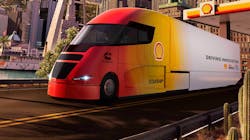As trucking transitions to alternative fuels, still focus on efficiency
Shell is once again putting its Starship vehicle on the road, but this time it will be equipped with a Cummins X15N natural gas engine that uses renewable natural gas.
The Starship program was launched in 2018 to demonstrate how currently available technology can be used to reduce energy use. The two previous Starship vehicles were powered by diesel.
See also: Shell Starship transitioning to natural gas
As you can imagine, this sort of project is right up NACFE’s alley since we are all about improving and maximizing freight efficiency. NACFE has been engaged with all of the Shell Starship efforts to date, verifying the freight ton efficiency by monitoring both the first Starship and the 2.0 version.
Starship 3.0 is going to promote lightweighting, low-rolling resistance tires, and lowering aerodynamic drag. These are all things we have been talking about for a decade and things we have covered in our Confidence Reports.
However, it is encouraging to see others promoting the same fuel-saving technologies we do, and even more exciting that Shell is looking at these technologies on trucks powered by something other than diesel fuel.
See also: Cummins reaches engine milestone: 2.5M engines made at Jamestown plant
As we navigate through a variety of powertrain options—in what we call the "messy middle"—we should not lose sight of the fact that we still want vehicles to be as efficient as possible. And that will mean paying attention to vehicle specifications and looking at add-on devices that can enhance freight efficiency.
Truck makers need to be prepared to make modifications to some of their alternative fuel vehicles in order to accommodate some of these fuel-saving devices. I have a lot of confidence that they will do this.
We all must keep in mind that even if these new powertrains are better environmentally than diesel, we still should want to optimize their efficiency. Getting more miles from a gallon of fuel—regardless of the fuel—not only saves money on fuel costs but also reduces emissions and, therefore, makes trucking even cleaner.
In August, the truck will make freight efficiency runs, and we will track ton-miles of goods shipped per kilogram of CO2 emitted. It's likely that we will measure and share more and different metrics than we did for the first two, diesel-based efforts. It’ll be very exciting to see how this turns out.
I encourage everyone in trucking to follow Starship 3.0 to see what can be learned.
Michael Roeth has worked in the commercial vehicle industry for nearly 30 years, most recently as executive director of the North American Council for Freight Efficiency (NACFE). He serves on the second National Academy of Sciences Committee on Technologies and Approaches for Reducing the Fuel Consumption of Medium and Heavy-Duty Vehicles and has held various positions in engineering, quality, sales, and plant management with Navistar and Behr/Cummins.
About the Author

Michael Roeth
Executive Director
Michael Roeth is the executive director of the North American Council for Freight Efficiency. He serves on the second National Academy of Sciences Committee on Technologies and Approaches for Reducing the Fuel Consumption of Medium and Heavy-Duty Vehicles and has held various positions with Navistar and Behr/Cummins.
